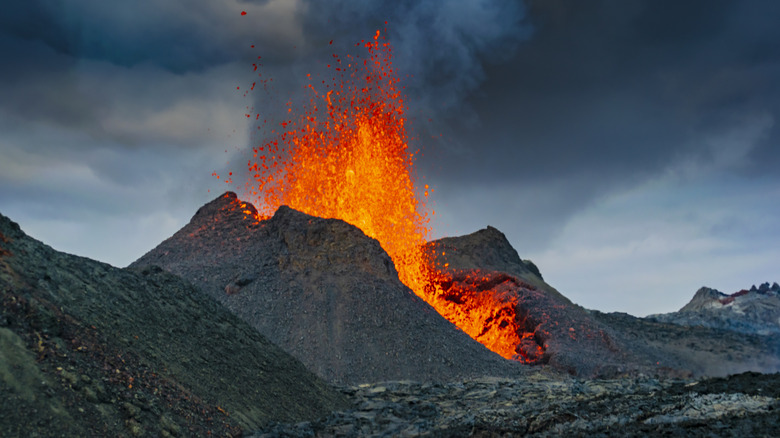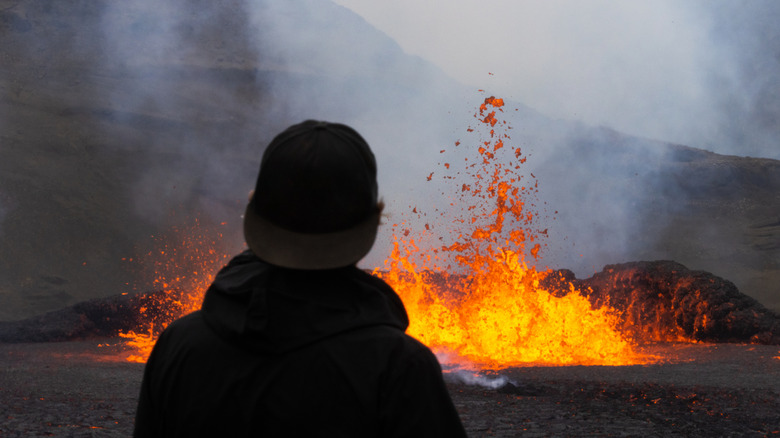Do Tourists In Iceland Need To Worry About A Volcanic Eruption? Rick Steves Weighs In
If you know people who have spent time in Iceland, you know how they describe the stark beauty of the Icelandic countryside. They show pictures of puffins on the rocks. They wax poetic about the strangeness of a 24-hour summer day. They tell hilarious stories about drinking too much Brennevín, a powerful Icelandic spirit. They recount their road trip around the famous Ring Road and all the amazing things you can see. Iceland is the new "it" country, having received 2.21 million visitors in 2023. Not only might you know someone who has freshly fallen in love with this Scandinavian island; you may be that person, proudly showing off your steamy selfies in Blue Lagoon.
But as popular as Iceland has become, there's still one teensy problem for tourists: the occasional volcanic eruption. The 2010 awakening of Eyjafjallajökull sent colossal clouds of ash into the atmosphere, hazing views and even clogging jet engines across Europe. In 2022, the eruption of Fagradalsfjall was visible 35 miles away in Reykjavik, the nation's capital. Iceland is no stranger to lava-spewing rifts, which begs the question: Should a traveler worry about visiting there?
Not surprisingly, European travel expert Rick Steves addressed this question in a blog post on his website. "Iceland is indeed one of the most volcanically active places in the world," he writes. "Volcanic eruptions, ejecting liquid lava, gas, ash, cinders, and/or solid rock (the biggest rocks are sometimes called 'volcanic bombs'), can last from a couple of days to several years." Then Steves adds: "Yet the odds that a volcano will be erupting during your visit are low." In short: No, you shouldn't have anything to worry about.
Frequent eruptions also pose a great opportunity for exploration in Iceland
Instead of fearing eruptions, Steves embraces the geomorphic lessons written into Iceland's landscape. "Volcanic sights make it easy and engaging to learn more about the island's unique geology," he says. "The island's entire surface is made of volcanic rock, most of it basalt (the igneous rock that forms when lava cools). Iceland's towering cliffs and jagged islands and skerries are all made of basalt, as are the miles of lava fields you're sure to see."
Indeed, Iceland straddles the Mid-Atlantic Rift, a crack in the earth between two continents. Iceland is home to more than 200 volcanoes, which have spewed land-making lava for the past 20 million years. This is pretty young for a modern land mass. By comparison, scientists estimate the Rocky Mountains are about 75 million years old, and the Appalachians were fully formed 250 million years ago. Iceland is a mere infant, with peach-fuzz vegetation and lava fields that can stretch beyond the horizon. Instead of growing pains, Iceland boils over with molten rock and sulfuric gases. But Icelanders tend to take these seismic events in stride.
"When eruptions do happen, they tend to be short-lived," Steves asserts. "Once an eruption site is deemed safe, authorities may designate some long-distance trails that hardy adventurers can safely hike for a better look at flowing lava." In the likely event that these volcanoes are too quiet to bother observing in person, here's a vacation-spanning list of affordable things to do in Iceland instead.

